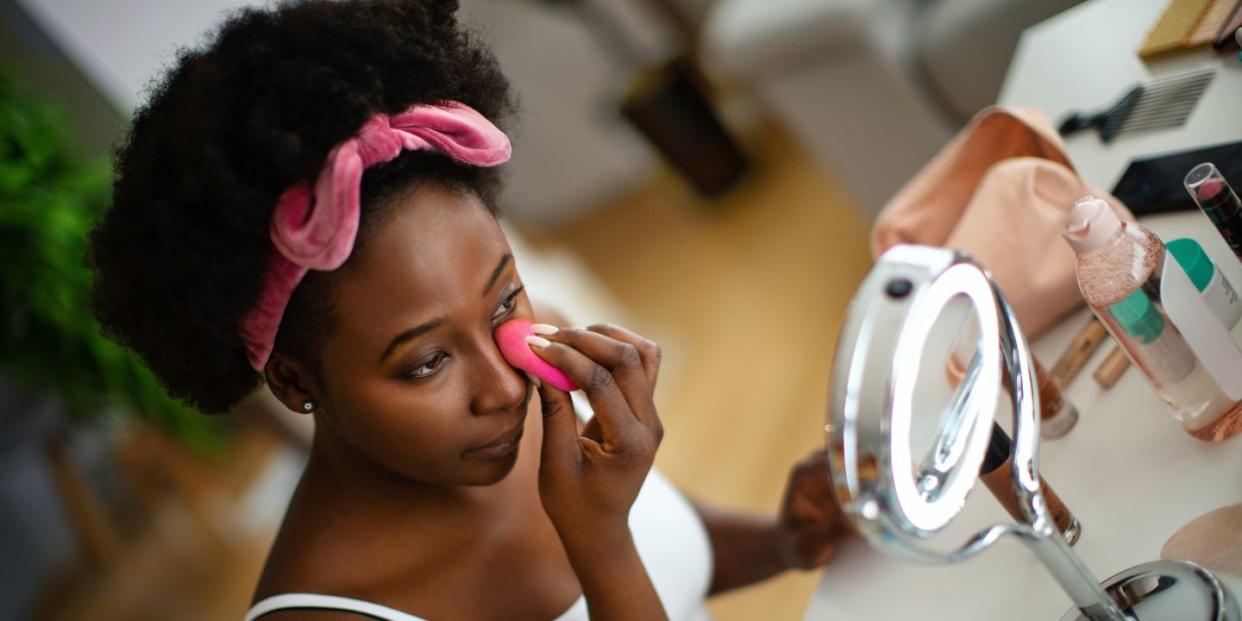Makeup Artists Say This Is The Trick to Applying Concealer

Whether you're struggling with big dark circles under your eyes, rosacea-prone cheeks, or a flare-up of hormonal acne around the jaw line, a good concealer can help. "Concealer helps create an even canvas on your face," says Natasha Moor, a professional makeup artist and founder of Natasha Moor Cosmetics. "Depending on your preference, you can use it to minimize or completely cover imperfections, blemishes, dark circles, acne, discolorations and spider veins. It’s one of the best products for anyone to use, and a little goes a long way."
Meet Our Experts: Natasha Moor, a professional makeup artist and founder of Natasha Moor Cosmetics, Melissa Hernandez, a celebrity makeup artist
But if you've ever applied concealer, you know that it doesn't always perform the magic it's supposed to. What gives?! Before you toss it aside in frustration, reevaluate the application process. Chances are you're not applying the formula correctly, because—yes—there is a right way (and a wrong way) to get the job done.
1. Select the right formula
Like other makeup products, there are different formulations for different skin types. If your skin is dry or sensitive, choose a lighter, hydrating liquid concealer, says Moor. If the formula is too thick, it will emphasize the dryness. If your skin is acne prone, choose a mattifying, clean formula, and avoid oil-based options, which can clog your pores. And if you have dark circles, use an orange concealer just in that area to color correct the blue appearance.
2. Wash your face
Before applying concealer (or any makeup for that matter!), cleanse and moisturizer your skin. Experts recommend using a gentle cleanser and lukewarm water, then patting dry. (Yes, there's a right way to wash your face.)
3. Apply eye cream
Make sure to thoroughly prep the under-eye area using eye cream, says celebrity makeup artist Melissa Hernandez. This will ensure a smooth and effortless concealer application.
4. Apply primer
To help your makeup go the distance, apply a primer before digging into your makeup bag. (If your skin skews oily, be sure to look for an oil-free version!) Application is simple: Use your fingers to massage the solution into the skin.
5. Start with foundation
A lot of people think concealer comes first, but makeup artists say the opposite yields more coverage and looks more natural. "I recommend applying concealer after foundation," says Hernandez. "Foundation acts as an even layer of coverage, allowing you to spot and correct areas that may need more attention with concealer."
6. Add concealer
Once you've applied your foundation, add a light layer of concealer on the inner and outer corner of the under eyes and blend out the edges, making sure to leave the lash line bare, says Hernandez. "Allowing some of the natural darkness to peak through creates a no makeup feel and the concealer is less likely to move or settle into fine lines." You can also add a layer of concealer to any areas that need a little more coverage—like blemishes or red spots.
For best results, dab on from the tube and then blend with a damp makeup sponge, says Moor. You want to press the product lightly into the skin, not wipe. Use as little concealer as possible and layer if you need more coverage, adds Hernandez.
7. Finish with a setting powder
Sweep a light layer of translucent powder under your eyes to lock the concealer into place, says Hernandez. This will prevent movement throughout the day for flawless, all day wear.
You Might Also Like

 Yahoo Movies
Yahoo Movies 
